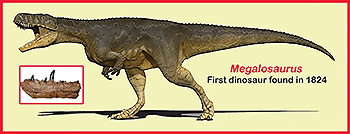 |
| Maps of the dinosaur tracksites at Willow Springs that from part of the Moab megatracksite. Note that trackways (T1-T4 etc.,) made by individual animals are easy to identify. |
Specialist trackers, known as ichnologists, speak of tracks (single footprints) and trackways (two or more consecutive tracks made by a single trackmaker, as you might make on a beach). There are also tracksites: these are areas where one or more track or trackway is found. For local and worldwide documentation and management of paleontological resources each tracksite is important regardless of size. A small tracksite may have rare tracks and be the only one in a particular unit of strata. On the other hand, it may be comparable to other tracksites in the area, or even worldwide.
Comparing tracks is a big part of ichnology. For example, we usually find the same or similar tracks in the same aged rocks in a particular area, and different tracks if the rocks are of different ages or in different areas. The Moab area has an excellent example of the former pattern of the distribution of similar tracks. If you go to Willow Springs, the Stomping Ground tracksite, or the Bull Canyon site high in the La Sal mountains you will be looking at large three toed tracks of Late Jurassic carnivorous theropods that are about 150 million years old. They occur in the same rock layers at the top of a unit of strata known as the Moab Member, on which there are a lot of off-road bike trails, especially just west of Arches National Park. Because these three tracksites are connected in the same strata they have been designated as part of the Moab Megatracksite. This term “megatracksite” is reserved for connected tracksites, usually many miles apart, which can be traced over large areas. They generally indicate large ancient environments, like coastlines, where similar trackmakers were active. This is the case with the Moab Megatracksite which represents the shore of ancient shallow sea that encroached on the Moab area in the Late Jurassic.
 |
| Tracks from the Moab Megatracksite were likely made by a dinosaur like Megalosaurus – the first ever named. The jaw found in England in 1824, is the first theropod fossil found and scientifically named, and is therefore one of the historically most famous dinosaur fossils |
There are about 10 megatracksites reported from around the world, including three from the USA, three from Europe and one from Africa. They are mostly Jurassic and Cretaceous in age, but there is no reason why one should not find tracksites from other geological time periods. The Moab Megatracksite is by far the best example in the world, this is mainly because the track-rich surface is so well exposed across the area. The BLM and Forest Service have provided interpretative signs at the three previously mentioned sites. Large three toed carnivorous dinosaur tracks named Megalosauripus are easily seen at all three sites. They are up to 18 inches long and probably stood at least 7 feet at the hip with a body length of 20 feet (6 meters). The name implies that the tracks may have been made by the Jurassic dinosaur Megalosaurus, which happens to be the first dinosaur ever named based on a discovery near Oxford in England in 1824, where the bones can be seen. Very few Megalosaurus bones are known, but their tracks are super abundant.
 |
| The stomping ground tracksite, pat of the Moab Megatracksite, was mapped (A) and photographed from the air (B) in the 1980s to reveal more the 2000 tracks. Notice it covers several acres. Track density is so high as to make it difficult to follow the trackways of individual animals. |
|